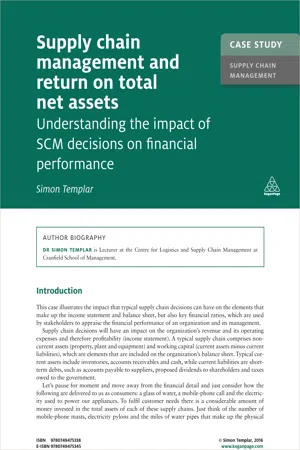
eBook - ePub
Case Study: Supply Chain Management and Return on Total Net Assets
Understanding the Impact of the SCM Decisions on Financial Performance
This is a test
- English
- ePUB (mobile friendly)
- Available on iOS & Android
eBook - ePub
Case Study: Supply Chain Management and Return on Total Net Assets
Understanding the Impact of the SCM Decisions on Financial Performance
Book details
Book preview
Table of contents
Citations
About This Book
Supply Chain Management and Return on Total Net Assets explores how supply chain management decisions have a direct bearing on the financial performance of fictional company FMCG. The case examines the Income Statement, Balance Sheet and financial ratios, tools used to measure the performance of a companyAimed at students on supply chain management courses, Supply Chain Management and Return on Total Net Assets demonstrates how the logistics and procurement functions' actions and performance are linked to the overall organizational performance.Register for a Kogan Page account at check-out to access and download your PDF after purchasing. You'll also have an opportunity to sign up when receiving your purchase confirmation email.
Frequently asked questions
At the moment all of our mobile-responsive ePub books are available to download via the app. Most of our PDFs are also available to download and we're working on making the final remaining ones downloadable now. Learn more here.
Both plans give you full access to the library and all of Perlego’s features. The only differences are the price and subscription period: With the annual plan you’ll save around 30% compared to 12 months on the monthly plan.
We are an online textbook subscription service, where you can get access to an entire online library for less than the price of a single book per month. With over 1 million books across 1000+ topics, we’ve got you covered! Learn more here.
Look out for the read-aloud symbol on your next book to see if you can listen to it. The read-aloud tool reads text aloud for you, highlighting the text as it is being read. You can pause it, speed it up and slow it down. Learn more here.
Yes, you can access Case Study: Supply Chain Management and Return on Total Net Assets by Simon Templar in PDF and/or ePUB format, as well as other popular books in Business & Operations. We have over one million books available in our catalogue for you to explore.
Information
CASE STUDY
SUPPLY CHAIN MANAGEMENT
Supply chain management and return on total net assets
Understanding the impact of SCM decisions on financial performance
Simon Templar

AUTHOR BIOGRAPHY
dr simon templar is Visiting Fellow at the Centre for Logistics and Supply Chain Management at Cranfield School of Management.
Introduction
This case illustrates the impact that typical supply chain decisions can have on the elements that make up the income statement and balance sheet, but also key financial ratios, which are used by stakeholders to appraise the financial performance of an organization and its management.
Supply chain decisions will have an impact on the organization’s revenue and its operating expenses and therefore profitability (income statement). A typical supply chain comprises non-current assets (property, plant and equipment) and working capital (current assets minus current liabilities), which are elements that are included on the organization’s balance sheet. Typical current assets include inventories, accounts receivables and cash, while current liabilities are short-term debts, such as accounts payable to suppliers, proposed dividends to shareholders and taxes owed to the government.
Let’s pause for moment and move away from the financial detail and just consider how the following are delivered to us as consumers: a glass of water, a mobile-phone call and the electricity used to power our appliances. To fulfil customer needs there is a considerable amount of money invested in the total assets of each of these supply chains. Just think of the number of mobile-phone masts, electricity pylons and the miles of water pipes that make up the physical infrastructure of each of these networks, but also the monies spent on operating expenses to deliver these products and services to us as consumers.
A fictional company FMCG Co has been used in this case to illustrate the impact of supply chain decisions on the financial performance of a business. The assumptions and costs used in the scenarios are indicative and are only to be used for training purposes, as they just illustrate the cause and effect relationship between supply chain decisions and financial performance. The full figures can be found in the Appendix. The traditional DuPont model has been adapted to illustrate the impact of supply chain decisions on return on total net assets rather than retur...
Table of contents
- Supply chain management and return on total net assets